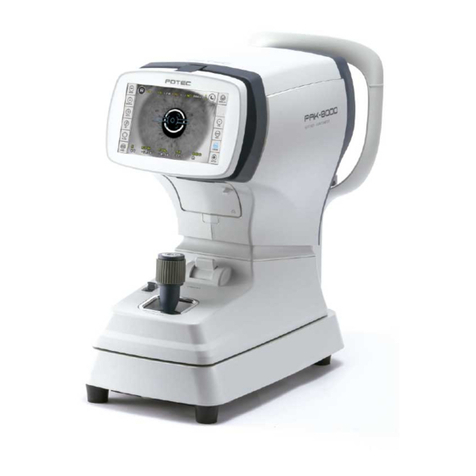PDR-7000 Operation Manual
2.6.3 Random chart function----------------------------------------------------------------------------------------------34
2.7 Printing--------------------------------------------------------------------------------------------------------------------------34
3 ADVANCED FEATURES-------------------------------------------------------------35
3.1 Vision Test Screens Presented to Patient--------------------------------------------------------------------------36
3.2 Data List------------------------------------------------------------------------------------------------------------------------38
3.3 Setting for connection with Chart projectors----------------------------------------------------------------------39
3.4 Setting Auxiliary Lenses--------------------------------------------------------------------------------------------------40
3.5 Fog Function for testing a single eye--------------------------------------------------------------------------------41
3.6 Fog Function for testing oth eyes-----------------------------------------------------------------------------------42
3.7 Calling Up Measurement Data.------------------------------------------------------------------------------------------43
3.8 Link Off Function------------------------------------------------------------------------------------------------------------43
3.9 Programming------------------------------------------------------------------------------------------------------------------43
3.9.1 Programming------------------------------------------------------------------------------------------------------------44
3.9.2 Operating programs--------------------------------------------------------------------------------------------------45
3.10 Entering Comments--------------------------------------------------------------------------------------------------------46
3.11 Setting Time and Date-----------------------------------------------------------------------------------------------------47
3.12 Touch-screen Panel Cali ration----------------------------------------------------------------------------------------48
3.13 Parameter Settings----------------------------------------------------------------------------------------------------------49
4 TEST METHOD-------------------------------------------------------------------------55
4.1 Unaided Visual Acuity Test----------------------------------------------------------------------------------------------55
4.2 Aided Visual Acuity Test--------------------------------------------------------------------------------------------------55
4.3 Astigmatism Test------------------------------------------------------------------------------------------------------------56
4.3.1 Astigmatism test with astigmatism clock dial---------------------------------------------------------------56
4.3.2 Astigmatism test with cross cylinder lens--------------------------------------------------------------------57
4.4 Spherical Refinement------------------------------------------------------------------------------------------------------58
4.4.1 Red-green test----------------------------------------------------------------------------------------------------------58
4.4.2 Cross grid test for far vision---------------------------------------------------------------------------------------59
4.5 Binocular Visual Function Test-----------------------------------------------------------------------------------------60
4.5.1 Binocular alance test-----------------------------------------------------------------------------------------------60
4.5.2 Polarized red-green test---------------------------------------------------------------------------------------------61
4.5.3 Phoria test----------------------------------------------------------------------------------------------------------------62
4.5.4 Phoria with fixation test---------------------------------------------------------------------------------------------64
4.5.5 Von Graefe test (horizontal phoria)-----------------------------------------------------------------------------66
4.5.6 Von Graefe test (vertical phoria)---------------------------------------------------------------------------------67
4.5.7 Vertical coincidence test--------------------------------------------------------------------------------------------68
4.5.8 Horizontal coincidence test----------------------------------------------------------------------------------------70
4.5.9 Scho er test-------------------------------------------------------------------------------------------------------------72
4.5.10 Stereo test----------------------------------------------------------------------------------------------------------------74
- viii -




























